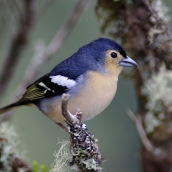Chaffinch (Fringilla coelebs)
Bird measuring 14-16 cm in total length and represented by five subspecies in Macaronesia: F. c. moreletti in the Azores; F. c. maderensis in Madeira; and three forms in the Canaries: F. c. ombriosa (El Hierro), F. c. palmae (La Palma) and F. c. canariensis (La Gomera, Tenerife and Gran Canaria). Recent genetic studies point to the existence of another exclusive subspecies in Gran Canaria, awaiting description. During migration periods and the winter season, the typical subspecies (F. c. coelebs) reaches the eastern Canary Islands and islets from Europe. The colouring of the subspecies varies considerably, especially for the males, as the extent and depth of blue on the back is much brighter in the Canary Island subspecies, and F. c. maderensis and F. c. moreletti have striking green patches; underparts are buff-coloured, depending on local forms. Invariably, the males have very pronounced broad white flashes on the wings. The females have buff-coloured backs and beige underparts, with two white flashes on the wings. This chaffinch has a variety of habitats throughout Macaronesia, mainly evergreen and fayal-brezal firetree and heath forests, but also damp pine forests (in the Canaries) and introduced coniferous woods, tree-covered farmlands and hedged pastureland (in the Azores), among others. In the Azores it is observed from sea level and at relatively low altitudes in Madeira. In the Canaries, however, it is generally seen above 400-500 m. It feeds on evergreen forest fruits, pine kernels and several invertebrates, and frequents recreational areas—as does the blue chaffinch (Fringilla teydea)—where it polishes off leftover food and waste. A clutch of 2-4 eggs is laid in a cup-shaped nest, usually camouflaged with lichens and moss and built in several species of trees and tall bushes. The breeding season varies according to archipelago: in the Canaries it can begin in late March, in the Azores in mid-May and in Madeira, eggs have been found in April. The latest brood is in August, and in the Azores, fledglings have been recorded until September. The different subspecies are abundant and have no conservation issues, except the one from El Hierro (F. c. ombriosa), which requires special attention because of a shrinking habitat, due to lack of space, and limiting factors such as forest fires and droughts.













